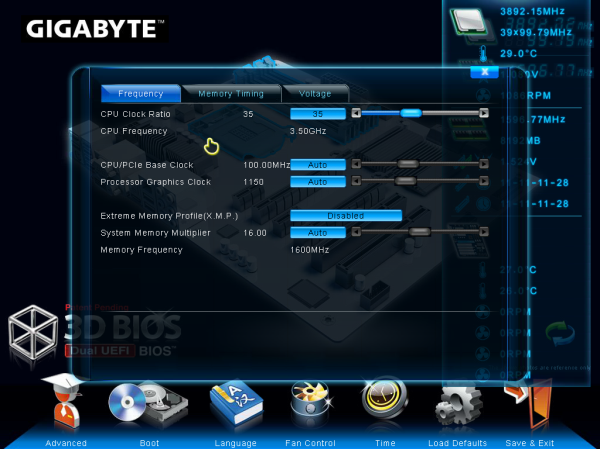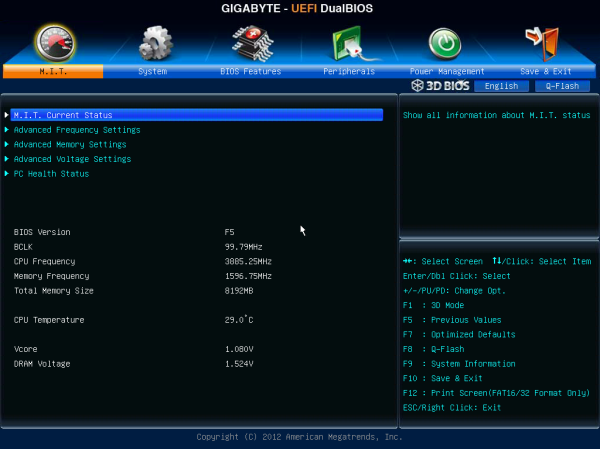Four Multi-GPU Z77 Boards from $280-$350 - PLX PEX 8747 featuring Gigabyte, ASRock, ECS and EVGA
by Ian Cutress on August 22, 2012 9:15 AM ESTGigabyte G1.Sniper 3 BIOS
The BIOS of a system is a measure of how much effort a manufacturer likes to put into every aspect of their design. A good BIOS reflects commitment and perseverance to producing a good product versus just getting one out there into the market. There is no use ever having one BIOS engineer on staff, even if a company only produces one motherboard. The design of the BIOS has to come from multiple sources, and a creative piece has to come out which improves the user experience and the functionality, rather than being merely another check point on the list.
So here we are with the Gigabyte G1.Sniper 3 BIOS, which is essentially an identical replica of the BIOS we saw on the Z77X-UD5H reviewed recently, despite this motherboard being part of the gaming range of Gigabyte motherboards. Our opening screen represents Gigabyte’s ‘3D’ mode screen, showcasing a representative motherboard on the screen. Different parts of the image are clickable, which present menus for the specific areas of the motherboard.
While this is a good way to introduce users to the BIOS, it does leave several questions, as we raised with the Z77X-UD5H. We have no text declaring which motherboard is being used (if the board is in a case), the BIOS version or the CPU. The motherboard point is the most poignant, as Gigabyte use a generic motherboard image in their 3D BIOS rather than one specific to the motherboard at hand. Other manufacturers also include information such as the temperatures, the memory count, memory speeds, voltages, and fan speeds on the front page – for Gigabyte’s model, we have to click through to find this information.
Users can also adjust the fan controls here, by clocking on the ‘Fan Control’ option on the menu at the bottom. As mentioned in previous Gigabyte reviews, the fan controls on their boards are not the best by any stretch, as the options available to users consist of choosing a fan ramp in terms of PWM values per degree. We would prefer options which relate to % fan speeds to temperature, with options to select initial and final temperatures and speeds such that the ramp was calculated automatically by the system. In our review of Biostar Z77 motherboards, we at least got an automatic testing option to tell us which PWM values should be set, even if they are an arbitrary scale for the majority of users should they wish to delve in and understand what is being said.
The main section of the Gigabyte BIOS is found in the Advanced option on the bottom row. This pulls up a more vintage style BIOS scenario, easily navigable by both the mouse and the keyboard. The first screen is labeled ‘MIT’, and we also get information regarding the BIOS version, the BCLK, memory size, temperatures and voltages here. The MIT screen also has a ‘Current Status’ option which gives a more detailed overview of some of the more important numbers relating to the hardware in the system.
The overclocking options are found in a series of three menus from the MIT screen. To adjust the CPU and memory frequencies, these options are found in the ‘Advanced Frequency Settings’ menu. In the ‘Advanced Memory Settings’ screen, the memory frequency is again adjustable, but also the subtimings are adjustable here. For voltages of the CPU or the memory, or other voltages in the system and Load Line Calibration settings, these are found in the ‘Advanced Voltage Settings’ menu. It is a little frustrating having to navigate between several menus at once to pick the CPU speed, and then set the appropriate voltage and LLC. I hope that in the future Gigabyte will make an all-in-one menu and have the appropriate options visible to see.
Elsewhere in the BIOS are the fan settings in a different menu format, as well as boot order selection, advanced peripheral management, and the BIOS flash utility.






_575px.png)
_575px.png)
_575px.png)
_575px.png)
_575px.png)














24 Comments
View All Comments
goinginstyle - Thursday, August 23, 2012 - link
I tried the G1 Sniper 3 and returned it a few days later. The audio was a significant downgrade from the Assassin series, EFI is clunky at best and the board had serious problems with a GSKill 16GB 2666 kit, not to mention the lousy fan controls.Purchased a Maximus Formula V and never looked back as the EFI, Fan Controls, Clocking and Audio are much better in every way compared to the Sniper board. There is no way Gigabyte has brought better value than ASUS with the Z77 chipset. You get what you pay for and the GB is overpriced once you actually use the board and compare it to ASUS or even ASRock.
JohnBS - Thursday, November 1, 2012 - link
I am looking for a rock solid MB, so of course I turned to ASUS. However, the reviews from verified buyers showed multiple issues with 3.0 USB ports losing power, system instability after months of use, and multiple instances of the board not working in one or more memory slots. Bent pins from the factory and complete DOA issues as well. A few reports of complete failure when the Wi-Fi card was inserted, yet gone with the card removed. This was mainly the Maximus IV series. Then I thought I'd look into the Maximus V series, because I really wanted ASUS, and was kinda sad to read reviews. Same issues from verified buyers of the Maximus V, more so with the USB 3.0 problems and the Wi-Fi/Bluetooth add-on card failures. In common were multiple complaints about customer service.So I emailed the ASUS rep who was replying to everyone's post, with specific attention on the recurring problems and how I was concerned about buying a MB. I got the email back, stating they were aware of the recurring problems listed on the user reviews, but that they are isolated occurrences.
I really need a rock solid x16 x 2 pci-e mb right now, and that's why I'm still searching. I'm planning on overclocking an i7-2700k with an gtx 690 and a 120z monitor for high res gaming. The sniper 3 looks good, but the front audio plug reaching the board's bottom audio header might be something I can't work around.
Just want something reliable. If there's a known issue, I'm always in that percentile that gets hit with the RMA process. I'm trying so hard to avoid that.
(Went with 690 instead of dual 680 for heat, noise, power draw considerations).
jonjonjonj - Friday, October 26, 2012 - link
you mean gigabyte in the evga conclusion?"the EVGA does not keep pace with ASUS and EVGA even at stock speeds."
couchassault9001 - Friday, November 2, 2012 - link
So for gaming benchmarks is it correct that the cpu multipliers were at 40 on the g1.sniper and 36 on the evga? if so it seems to be a rather unfair comparison. Being that the sniper cpu is running 11% fasterI'd be amazed if someone was looking at these boards with no intent to overclock like crazy, as i'm trying to decide between these 2 boards myself, and i'm sure i'll be pushing my 3770k as far as it will go.
The evga consumed ~8% less power than the sniper under load.
dirt 3 showed a 9% frame rate drop in the frame rate going from g1 to evga. metro 2033 showed a 3.6% drop in frame rate going from g1 to evga. Both of these are on the 4 7970 benchmarks. the 3 and below the gap is much tighter with it being under 1% with one card.
I know this may be nit picking to some, but i plan on running 5760x1080 3d so 4 7970 performance on a i7-3770k is exactly what i'm looking at.